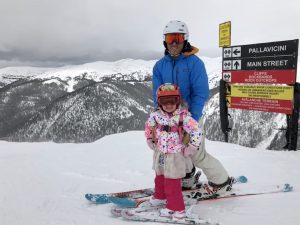It may be the end of ski season for another year, but we’re always trying to figure out what factors impact the value of real estate in those wealthy areas. This week, Colorado-based HBG Researcher Josh Ostroski shares his insider information on three things he knows really well: skiing, real estate, and prospect research! ~Helen
I grew up in a skiing family in New England and it has been a passion of mine since I can remember. One day a colleague at HBG was researching someone that had a house in Lake Tahoe which had a market value drastically lower than what they paid for it. My colleague asked what some of the factors could be that might cause this, outside the obvious decline due to the housing crisis that hit California especially badly. The more we discussed it, the more it became obvious that there were more things at play in these specialized locations than elsewhere. I decided to look more deeply into the factors that impact housing costs in resort towns, and I thought you might be interested to know what I found.
Markets
Sotheby’s Resort Report 2018, which provides market stats on the major resort areas of the western U.S., shows that home prices have continued to rise while days on market have decreased at nearly all the resort areas.
New England resorts are also doing well, as “prices of luxury homes in Vermont’s top ski areas are rising twice as fast as the median price in those areas—the opposite of trends nationwide, where median prices are rising faster than luxury prices, says Danielle Hale, chief economist at real-estate website Realtor.com” in this Wall Street Journal article from November 2017.
New England resorts to keep an eye on for property value increases are Stowe (VT), Stratton (VT), Bretton Woods (NH), Sugarbush (VT), and Sugarloaf (ME). (Beware, though, it’s not smooth gliding across the board in New England: private mountain Hermitage Club in southern Vermont was recently foreclosed on due to owing taxes and lack of loan payments on some of its properties.)
It is not just the luxury market that is doing well: condos/townhomes in some resort towns are actually increasing in value at higher rates due to more inventory and more potential buyers.
Powder Magazine recently listed its “Next American Ski Towns,” which are places to keep an eye on as people get priced out of the more well-known areas and markets and amenities increase in these smaller ones.
Also, according to Bloomberg’s “Wealthiest Small Towns in America” you will find many are located near ski resorts.
Climate
Climate change has caused winters to become shorter and more unpredictable.
The winter of 2016-2017 was record-breaking for snowfall in California, but the six years prior were some of the lowest snowfall totals in recent history. This means that fewer people are planning ski trips to California because of the unreliability of the skiing/weather. This uncertainty has negatively affected the real estate values in California ski areas.
Another factor to think about is the elevation of many resort towns. The majority of California ski resorts’ base elevations range from 6,000 ft. to 7,200 ft. By comparison, the resorts of Summit County, CO (Arapahoe Basin, Breckenridge, Copper, and Keystone) have base elevations that range from 9,200 to 10,500 feet. The higher resorts will be able to withstand the warmer winters that have been occurring and are predicted to continue to occur. A prominent climate scientist recently said that Summit County, CO will likely see a 10% decline in snow by 2050, which means it will likely fare much better than most, and will be one of the few places left with reliable snow.
The same goes for resorts in the northeast, which are also feeling the effects of climate change that can’t be fixed merely with more snow-making.
The amount of snowfall (or cold air for that matter) a region is getting can have a significant impact on not only the value of the property, but the potential income if used as a rental. This could also prompt a prospect to sell their property which could be a liquidity event if they have built up equity in the property.
More Than Just Skiing
Coinciding with climate change, the rising cost of doing business (insurance, electricity, wages) is forcing ski resorts to adapt and become year-round destinations. Resorts cannot sustain being closed the majority of the year any longer and more and more resorts are becoming year-round destinations with the addition of mountain coasters, downhill mountain biking trails, zip lines, hiking, and special events/concerts.
As a result, summer is contributing more to mountain town economies than ever before. Tax revenue in the summer of 2017 was over 50% higher than it was four years ago in Telluride and Mountain Village, CO., according to data collected by Michael Martelon, president of the Telluride Tourism Board. In Vail, summer tax revenue in 2016 was 34% higher compared with the same period four years prior, according to data provided by the town of Vail.
In addition to the new summer activities in ski towns, many visitors from hot climates like Texas who can afford to are staying the entire summer in the mountain towns of Colorado, which is contributing to increased real estate market.
Rental income
Often second home owners are either using their property as a fulltime rental or partial rental. When you’re researching someone and discover a second home, it is worth a check on sites like Airbnb, VRBO, Zillow, or a local management firm to see if the property is being rented and if so, at what rate. You may discover another stream of income for the prospect.
Keep in mind, though, that even when using sites like Airbnb and VRBO, there may be some management fees incurred by the homeowner. When using a local management firm their fees are usually higher, typically 25%-50% of rental income, but they take care of marketing, booking, maintenance calls, etc. Even if a property has decreased in value from when it was purchased, if it is being rented and someone else is paying down the mortgage (on top of possibly making money from the rental income), it can still be beneficial for the owner to hold onto it.
Ski Resort Consolidation
Skiing/snowboarding is an expensive activity, which in and of its self is a likely indicator of wealth, although not always. The ski industry has been working hard to make it more affordable, starting with Vail Resort’s wildly popular Epic Pass, a multi-mountain pass that has been around since 2008. This pass made skiing/snowboarding much more affordable when buying a season pass. Buying a day pass is still VERY expensive, though: Vail, $199; Aspen, $169; Deer Valley, $135; Stowe, $131.
Multi-mountain passes have become even more popular the past few years, including Aspen Resorts’ own Ikon Pass. An Epic Pass gets you unlimited skiing/snowboarding at 64 resorts around the world for $899; while the Ikon Pass offers two versions for $899 (26 resorts) and $599 (10 resorts) respectively.
How does this affect real estate? It has created a greater number of skier/riders, particularly at resorts that are near major urban areas (like Denver, Salt Lake City, Boston/New York, and the Bay Area), thus increasing traffic. Coupled with the often snow-covered or closed roads, this has created more demand for local housing, as people don’t want to spend six hours sitting in the car to do a 1.5 hour drive (I’ve done this too many times myself). I spoke with a realtor in Summit County, CO about this and he said the increased traffic has been great for business as it has created much higher demand.
Income Gap
The median income is high for most resort towns, but there is also a large income gap. This causes a strain on resorts as the workers that are vital to keeping a business running cannot afford housing.
For example (in an ironic twist of fate): in 2017, Summit County, CO finally found the ideal candidate for Executive Director of its Housing Authority, but the candidate had to turn the job down because housing in the county was too expensive.
For more on this, check out this article on the struggles of finding housing in ski towns. Affordable housing is key to a stable economy and if solutions aren’t found in these resort towns, it could negatively affect the economy and market.
And finally, Taxes
The last factor I wanted to mention that affects resort real estate is taxes. It is said that the new tax reform bill for 2018 which puts a $10,000 limit on mortgage interest deductions will likely have a negative impact on real estate prices. We’ll have to wait and see how that plays out.


